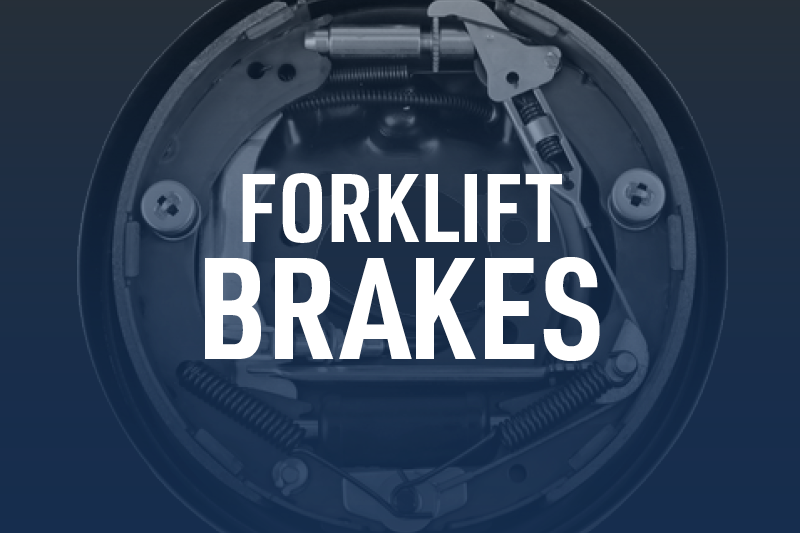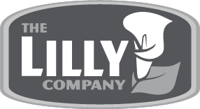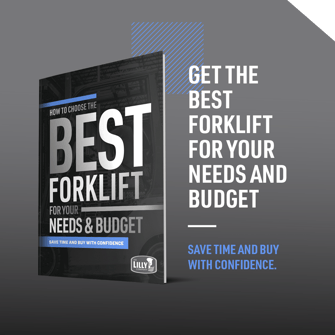
.png?width=894&name=Blog%20Image%20-%20Forklift%20Brakes%20(1).png) Forklift brakes have a simple but important job: to stop a forklift carrying thousands of pounds. Most people don’t think twice about their forklift brakes, until they start acting up. When your forklift can’t slow down or stop in time, people get hurt, and valuable product gets damaged.
Forklift brakes have a simple but important job: to stop a forklift carrying thousands of pounds. Most people don’t think twice about their forklift brakes, until they start acting up. When your forklift can’t slow down or stop in time, people get hurt, and valuable product gets damaged.
In this article, we’ll review the most common types of forklift brakes and a braking technique called forklift plugging. We’ll also cover the most common reasons forklift brakes need repair and how to avoid these issues.
Different Types of Forklift Brakes
Let’s get right to the most frequently asked question: what type of brakes do most forklifts have? Answer: drum and shoe brakes.
Drum and Shoe Forklift Brakes - the Basics
When the operator pushes down on the brake pedal, the brake shoes press against the brake drum, creating friction, which slows down the lift truck. Over time, the part that presses against the drum (the brake shoe lining) wears down and must be replaced.
Forklift brake shoes should last 5,000 - 7,000 hours if properly maintained. Every 250 hours, you should blow out accumulated brake dust to prevent it from grinding ridges into the brake shoes (or worse - the brake drum). The brake shoes and drum also require periodic adjustments and maintenance.
If you find you’re replacing your brake shoes frequently:
- Consider forklift operator retraining - the most common reasons forklift brakes need to be replaced earlier than normal are: driving with the parking brake engaged, driving two-footed, and driving too fast.
- If you have a heavy-duty, grimy, or dusty work environment - consider wet disc brakes.
Wet Disc Brakes aka “Wet Brakes”
Oil-cooled disc brakes, better-known as wet brakes, use hydraulic pressure to squeeze the discs and slow the drive axles. The mechanism is completely sealed and protected from dust, debris and grime, so you don’t have to worry about contamination or corrosion.
Wet brakes rarely need to be replaced and only require periodic oil changes. They’re a cost-effective alternative to drum and shoe brakes for many applications.
Other Types of Lift Truck Brakes
Air Brakes
Air brakes are typically used in larger, heavy-duty vehicles and require an engine-driven air compressor. As the name suggests, air brakes slow the truck by using compressed air (pressing on an actuator) to apply force to the brake shoe or pad.
Hydrostatic Drive Brakes
Some forklifts use a hydrostatic drive instead of a mechanical powertrain. With a hydrostatic forklift, hydraulic fluid gets pumped directly to the wheels. When the accelerator is disengaged, fluid stops flowing and there is a natural braking effect.
If your material handling application would benefit from smooth, gradual starts and stops, hydrostatic drive forklifts are an excellent choice. Linde forklifts are well-known for their 100% hydrostatic drives.
Regenerative Braking/Forklift Plugging
Forklift plugging, also known as switch-back or regenerative braking, is strictly for electric forklifts. Using the right combination of the accelerator pedal and directional selector, a forklift operator can slow down and change direction without using the forklift’s brakes.
As the electric motor reverses direction, kinetic energy is converted into electricity, which extends the run-time. This is why forklift plugging is also called regenerative braking.
Forklift plugging takes some practice. Make sure operators are properly training and emphasize they should never use this technique on an internal combustion engine forklift.
Forklift Brakes Not Working Right?
Brake squeal and other noises don’t always signal a problem. Sometimes brakes can feel more “grabby” after the forklift has been sitting overnight, especially when the forklift is driven without a load.
It’s better to have a professional inspect your forklift’s brakes regularly so you can catch small issues before they become big problems. That way, when an operator comes to you worried about a brake problem, you can refer to the service record and know, “that seems normal, it’s about time to replace the brake shoe linings,” versus having no history and hoping there isn’t an expensive repair lurking under the hood.
Order Forklift Brake Parts or Schedule Forklift Brake Service
Your forklift’s brakes work hard day-in and day-out to decelerate and stop thousands of pounds. Whether they’re pad brakes, drum brakes, or an option such as oil-cooled, your brakes will eventually need replacement. The Lilly Company carries original OEM parts for the brands we represent (Toyota, Clark and Linde), and we also have the most comprehensive inventory of forklift parts for all makes and models in Alabama, Mississippi, Tennessee and eastern Arkansas.
When your forklift brakes need repair, trust the service pros at The Lilly Company. Our factory-certified technicians can service any make or model of forklift, and we offer maintenance plans designed to keep your equipment running at peak efficiency (while keeping costs low).
The Lilly Company serves customers throughout Alabama, Mississippi, Tennessee and eastern Arkansas. Contact a forklift expert online or by phone 800-238-3006 with any questions you may have, or visit one of our 13 locations across the mid-South.
Arkansas – Jonesboro
Alabama - Birmingham, Dothan, Irondale, Madison, Mobile, and Montgomery
Mississippi - Tupelo and Richland
Tennessee - Jackson, Kingsport, Knoxville, and Memphis
Posts by Tag
- Forklift (55)
- Forklift Service (17)
- Electric Forklifts (12)
- Forklift Attachments (11)
- Forklift Safety (10)
- Toyota Forklifts (10)
- Warehouse Planning (9)
- Loading Docks (7)
- Pallet Racking (7)
- Parts (7)
- Customer Solutions (6)
- Material Handling Education (6)
- Purchasing Options (6)
- Clark Forklifts (5)
- Forklift Rental (5)
- Heavy Equipment (5)
- Forklift Batteries (4)
- Forklift Fleet Management (4)
- Forklift Tires (4)
- Forklift Training (4)
- Products (4)
- Aerial Equipment (3)
- Forklift Accessories (3)
- Specialty Forklifts (3)
- Used Equipment (3)
- Yard Spotter Trucks (3)
- IC Forklifts (2)
- Linde (2)
- Manitou (2)
- Pallet Jacks (2)
- Warehouse Doors (2)
- COMBiLift (1)
- Custom Shop (1)
- Forklift Brakes (1)
- Forklift Warranty (1)
- Gehl (1)
- Komatsu (1)
- Product Review (1)
- Recruitment (1)








